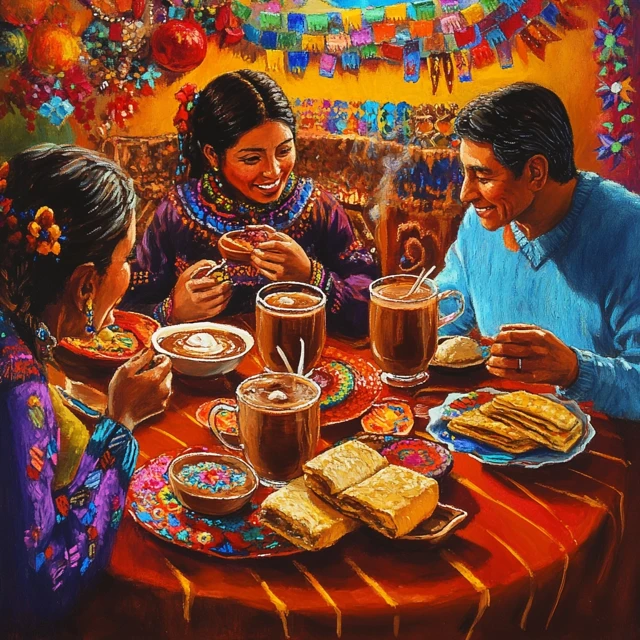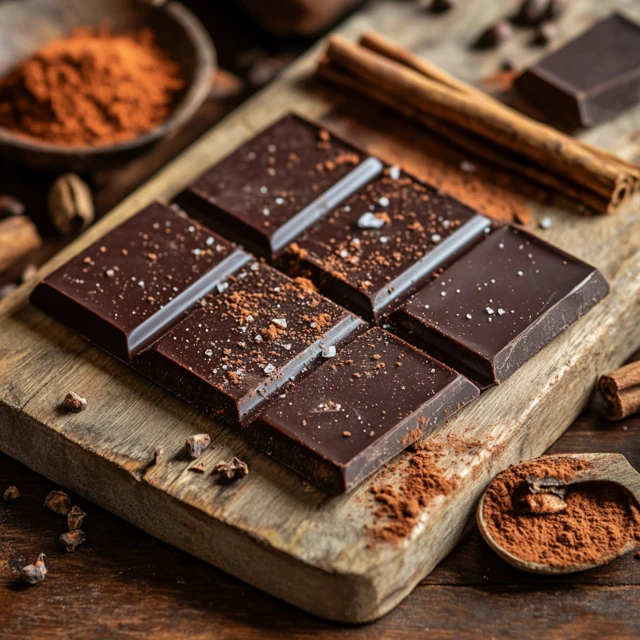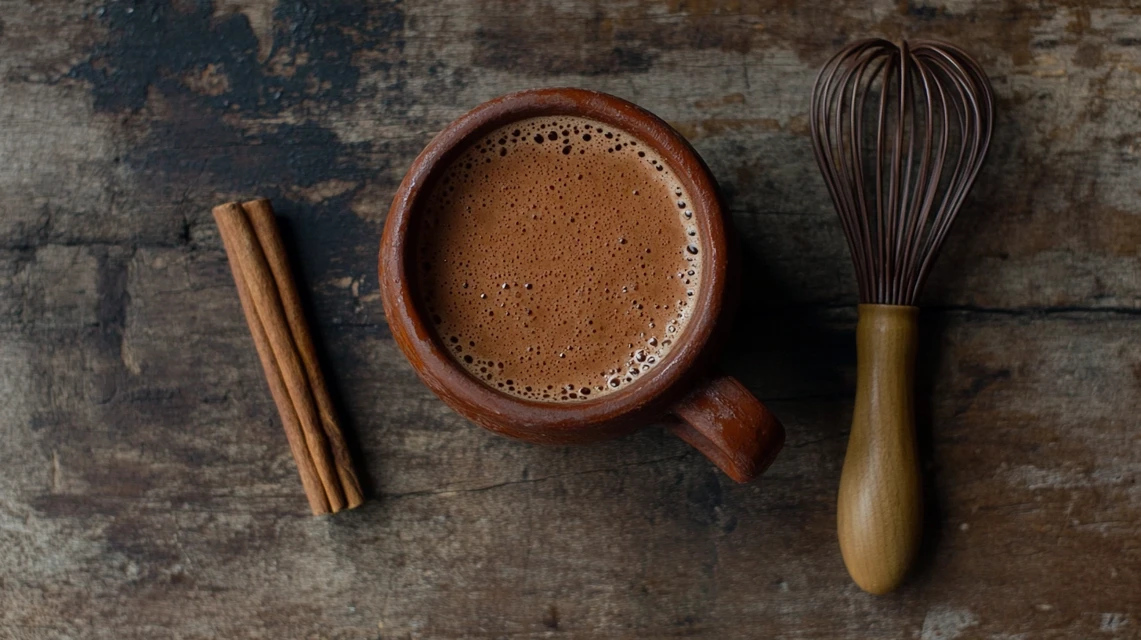Mexican hot chocolate is more than just a warm beverage—it’s a flavorful and cultural experience. It stands apart from regular hot chocolate in its bold ingredients, unique preparation techniques, and rich cultural significance. Let’s dive into the details of what makes Mexican hot chocolate truly one of a kind.
Unique Ingredients in Mexican Hot Chocolate
The ingredients used in Mexican hot chocolate are what give it its signature flavor and texture. Unlike regular hot chocolate, which relies on plain cocoa powder and sugar, Mexican hot chocolate incorporates spices and special types of chocolate that create a distinctive taste.
Spices That Define the Flavor
One of the standout features of Mexican hot chocolate is the use of spices, which elevate it beyond a simple sweet drink. These spices add depth, warmth, and a slight kick that balances the cocoa’s richness.
- Cinnamon: A key ingredient in almost every recipe, cinnamon brings a warm, aromatic sweetness that complements the chocolate.
- Chili Powder or Cayenne: A small pinch of chili or cayenne adds a subtle heat, creating a complex flavor profile that sets it apart from traditional hot chocolate.
- Vanilla: Vanilla extract or bean enhances the overall flavor, adding a smooth and sweet undertone.
- Nutmeg or Star Anise: Occasionally, recipes include these spices for additional warmth and complexity.
The interplay of these spices creates a drink that is comforting yet exciting with every sip.
The Role of Mexican Chocolate Tablets

Mexican hot chocolate is traditionally made using special chocolate tablets, which are different from the processed cocoa powders or syrups found in regular hot chocolate.
- What Are Mexican Chocolate Tablets?
These are solid discs or bars of chocolate made from ground cocoa beans, unrefined sugar, and cinnamon. Popular brands include Abuelita and Ibarra, but many families also use artisanal versions made locally. - Why They’re Unique:
- Coarse Texture: The sugar and cocoa nibs are minimally processed, giving the chocolate a grainy texture that contributes to the drink’s authenticity.
- Flavor Profile: The pre-spiced nature of the tablets simplifies preparation while providing a robust, earthy flavor.
These tablets are the heart of Mexican hot chocolate, providing a base that combines tradition and taste.
Sweetness and Texture
The sweetness and texture of Mexican hot chocolate differ significantly from the smooth and overly sweet profile of many commercial hot chocolate mixes.
- Balanced Sweetness:
- While the chocolate tablets contain unrefined sugar, the sweetness is more natural and less overpowering compared to sugary syrups or powders.
- Some recipes allow for added sweeteners, letting individuals customize the drink to their liking.
- Grainy Texture:
- The coarse sugar and cocoa nibs in Mexican chocolate tablets give the drink a slightly grainy consistency, which is a hallmark of authenticity.
- This texture adds a rustic charm that regular hot chocolate lacks, making each sip unique.
Preparation Methods That Stand Out
The way Mexican hot chocolate is prepared is just as important as the ingredients. Traditional methods ensure that every cup has the perfect flavor, texture, and frothiness.
The Use of a Molinillo Whisk
A defining feature of Mexican hot chocolate preparation is the use of a molinillo, a traditional wooden whisk. This tool isn’t just functional—it’s also a piece of cultural heritage.
- What Is a Molinillo?
A molinillo is a carved wooden whisk with rings that rotate when rolled between the hands. It’s specifically designed to froth hot drinks like Mexican hot chocolate. - Why It’s Important:
- Creates Froth: The molinillo adds air to the drink, creating a frothy top layer that enhances both the texture and presentation.
- Even Mixing: It ensures the chocolate, spices, and milk or water blend seamlessly.
Using a molinillo isn’t just about tradition—it’s also about achieving the perfect consistency.
check out this https://eassyrecipes.com/category/breakfast/
Traditional vs. Modern Preparation
While the traditional preparation of Mexican hot chocolate involves a stovetop and a molinillo, modern methods have adapted to fit busy lifestyles.
- Traditional Method:
- Heat milk or water in a pot on the stove.
- Add broken pieces of Mexican chocolate tablets.
- Use a molinillo to stir and froth the drink until the chocolate is fully melted and blended.
- Modern Method:
- Some use blenders or handheld frothers to achieve a similar frothy texture.
- Microwaving milk or water and stirring with a spoon is a quick alternative, though it sacrifices the authenticity of the process.
While modern methods are convenient, many still prefer the traditional approach for its cultural significance and superior results.
check out this https://eassyrecipes.com/category/breakfast/
Creating the Signature Froth
The froth is an essential element of Mexican hot chocolate, and achieving it requires some technique.
- Why Froth Matters:
- It adds a creamy texture to the drink, making it feel indulgent.
- The frothy layer enhances the flavors by incorporating air, which carries the aroma of the spices and chocolate.
- How to Achieve It:
- Use a molinillo or a whisk to vigorously stir the drink until bubbles form on the surface.
- Blend the drink in a high-speed blender for a modern alternative.
The froth not only elevates the drink’s appearance but also contributes to its rich, luxurious texture.
Cultural Significance of Mexican Hot Chocolate
Mexican hot chocolate is much more than a simple beverage. It holds a deep cultural significance, symbolizing heritage, community, and tradition. Its rich history and presence in celebrations make it a drink that connects people and preserves the essence of Mexican culture.
A Symbol of Heritage and Community
Mexican hot chocolate represents the roots of Mesoamerican culture, dating back to the Aztecs and Mayans. For these ancient civilizations, cacao was considered a sacred gift from the gods and was used in ceremonies, rituals, and daily life.
Cultural Roots:
- Sacred Cacao: The Aztecs and Mayans valued cacao as both a currency and a ritualistic offering. Their early versions of hot chocolate, known as xocoatl, were often unsweetened and included spices like chili, reflecting the bold flavors still present today.
- Spanish Influence: When the Spanish arrived, they introduced sugar and milk, transforming the bitter xocoatl into the sweetened hot chocolate we know today. This blend of indigenous and European influences symbolizes the merging of two cultures.
- Regional Variations: Across Mexico, each region has its own take on hot chocolate, reflecting local ingredients and traditions. This diversity showcases the drink’s adaptability and importance in different communities.
Through its ingredients and preparation, Mexican hot chocolate serves as a link to the past, honoring the legacy of those who first cultivated cacao.
A Drink for Sharing:
- In many Mexican households, hot chocolate is prepared in large batches to share with family and friends.
- The act of making and drinking it together fosters a sense of belonging and togetherness, reinforcing its role as a communal symbol.
Its Role in Celebrations and Rituals
Mexican hot chocolate is deeply intertwined with celebrations and rituals, making it more than just a beverage. It’s a key element in events that honor family, tradition, and life itself.
check out this https://eassyrecipes.com/category/breakfast/
Día de los Muertos (Day of the Dead):
- Offerings for the Departed: During this sacred celebration, families create altars called ofrendas, where they place food, drinks, and mementos for their loved ones who have passed. Mexican hot chocolate is a common offering, symbolizing warmth and comfort.
- Shared Memories: Families often drink hot chocolate together as they reminisce about the departed, creating a connection between the living and the spiritual world.
Christmas and Winter Gatherings:
- A Festive Favorite: Mexican hot chocolate is a staple during the holiday season, paired with traditional foods like tamales and rosca de reyes (Three Kings Bread).
- Comfort in Cold Weather: The warm, spiced drink brings comfort and joy to family gatherings, making it an essential part of Christmas celebrations.
Everyday Rituals:
- Breakfast Tradition: In many homes, Mexican hot chocolate is a breakfast staple, served with pan dulce (sweet bread) or churros.
- A Morning Ritual: Preparing and drinking hot chocolate is a calming way to start the day, symbolizing care and nourishment.
Through its presence in both grand celebrations and daily routines, Mexican hot chocolate becomes a symbol of life’s special moments.
Why It’s More Than Just a Drink

Mexican hot chocolate transcends its role as a beverage to become an emotional and cultural experience. It evokes feelings of nostalgia, comfort, and connection, making it a deeply meaningful part of Mexican heritage.
Connection to the Past:
- Each cup of Mexican hot chocolate tells a story of ancient traditions, colonial influences, and modern adaptations.
- It serves as a reminder of the resilience and creativity of the cultures that shaped it.
A Comforting Presence:
- The warm spices and creamy texture make Mexican hot chocolate a source of comfort during challenging times.
- Its preparation often involves care and love, making it a heartfelt gesture when shared with others.
A Symbol of Celebration:
- Whether served during festive gatherings or enjoyed quietly at home, Mexican hot chocolate adds a sense of celebration to any moment.
- Its versatility makes it suitable for all occasions, from grand holidays to simple family breakfasts.
Global Appeal:
- While deeply rooted in Mexican culture, Mexican chocolate has gained worldwide recognition for its bold flavors and unique preparation.
- It serves as a cultural ambassador, introducing people to the rich traditions of Mexico.
FAQs About Mexican Hot Chocolate
Mexican hot chocolate is beloved for its bold flavors, unique texture, and cultural significance. Below are answers to frequently asked questions that highlight what makes this drink so special.
Why Does Mexican Chocolate Taste Different?
Mexican chocolate has a distinct taste because of its ingredients and preparation methods. Unlike regular chocolate, which is smooth and uniform, Mexican chocolate embraces a more rustic and flavorful profile.
Key Reasons for the Unique Taste:
- Spices: Traditional Mexican chocolate is infused with spices like cinnamon and sometimes chili, giving it a warm and slightly spicy kick.
- Unrefined Sugar: The use of piloncillo (a type of unrefined cane sugar) adds a natural sweetness with a hint of molasses.
- Cocoa Nibs: Mexican chocolate often contains ground cocoa nibs, which provide a deeper, earthier flavor compared to highly processed chocolate.
These elements combine to create a taste that is rich, complex, and uniquely Mexican.
Why Does Abuelita Hot Chocolate Taste Different?
Abuelita hot chocolate, a popular brand of Mexican chocolate, has its own distinct flavor that sets it apart from other types of hot chocolate.
What Makes Abuelita Unique?
- Pre-Spiced Formula: Abuelita chocolate tablets are pre-flavored with cinnamon, giving the drink its signature warm and aromatic taste.
- Granulated Texture: The sugar and cocoa nibs in Abuelita chocolate are less refined, creating a grainy texture that enhances the authenticity of the drink.
- Cultural Nostalgia: For many, the taste of Abuelita hot chocolate is tied to memories of family gatherings and traditions, making it taste even more special.
The combination of these factors makes Abuelita hot chocolate a comforting and flavorful choice that resonates with many families.
Why Is Mexican Hot Chocolate So Good?
Mexican hot chocolate is often praised for its rich, complex flavors and comforting qualities. But what exactly makes it so irresistible?
Why It Stands Out:
- Flavor Layers: The combination of cocoa, cinnamon, and sometimes chili creates a multi-dimensional flavor profile that’s both sweet and spicy.
- Frothy Texture: Traditional preparation with a molinillo whisk adds a creamy froth, enhancing the drink’s mouthfeel.
- Cultural Significance: The cultural ties and history associated with Mexican chocolate add emotional depth, making each cup feel like a celebration of heritage.
- Versatility: It can be enjoyed on its own, paired with pan dulce (sweet bread), or customized with additional spices and flavors.
Its ability to bring together flavor, texture, and tradition makes Mexican chocolate an unforgettable experience.
Why Is Mexican Hot Chocolate Gritty?
The gritty texture of Mexican chocolate is one of its defining characteristics, setting it apart from the smooth consistency of regular hot chocolate. This texture is a result of its unique ingredients and traditional preparation methods.
Reasons for the Grittiness:
- Unrefined Sugar: The granulated, unprocessed sugar in Mexican chocolate doesn’t fully dissolve during preparation, leaving a slightly grainy texture.
- Cocoa Nibs: Ground cocoa nibs are often included in Mexican chocolate tablets, contributing to the rustic feel of the drink.
- Minimal Processing: Unlike commercial chocolate powders, Mexican chocolate is less processed, which preserves its natural texture and flavor.
Many people consider the gritty texture a hallmark of authenticity, adding to the rustic charm and sensory experience of Mexican chocolate.
Conclusion
Mexican hot chocolate is a drink unlike any other, combining bold flavors, unique textures, and rich cultural significance. Its distinct taste comes from a blend of spices, unrefined sugar, and traditional preparation methods, while its gritty texture adds a rustic and authentic touch. Whether you’re savoring Abuelita hot chocolate or preparing your own from scratch, Mexican chocolate offers a sensory and cultural experience that is truly special. Each cup is a celebration of tradition, flavor, and connection, making it a beloved beverage around the world.

